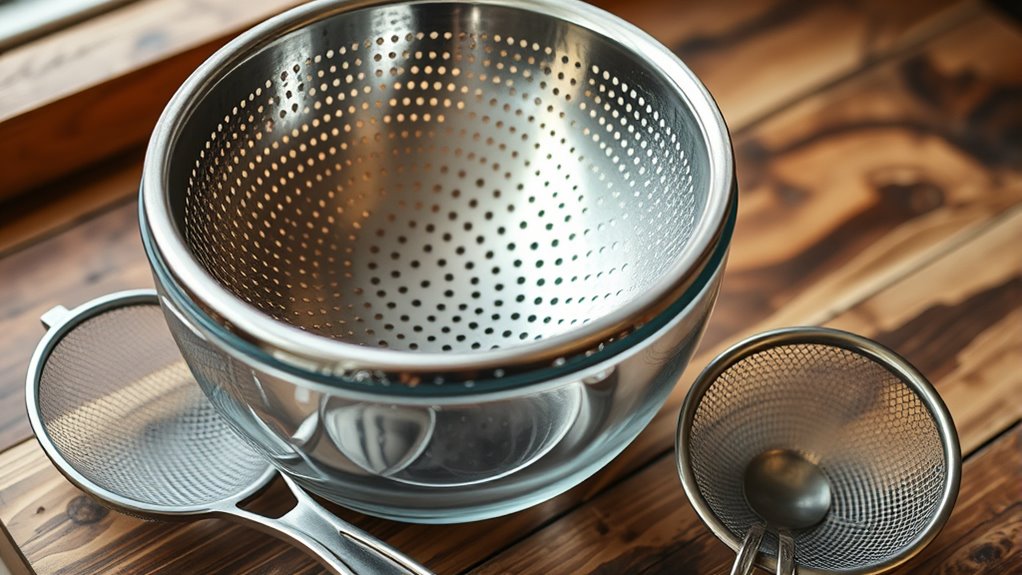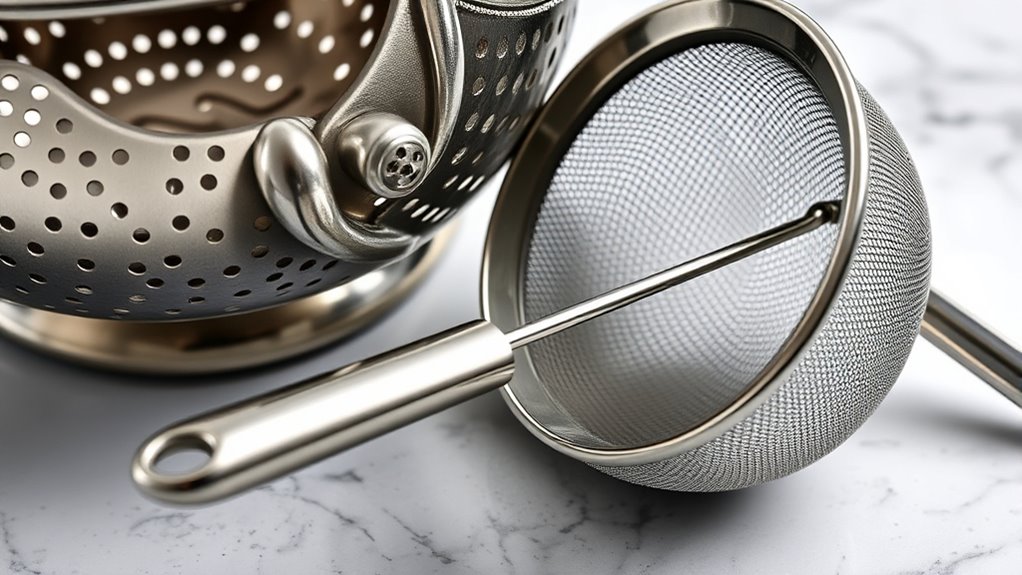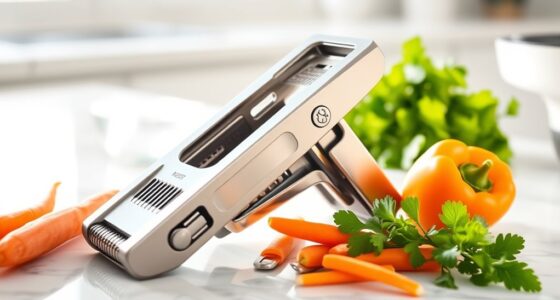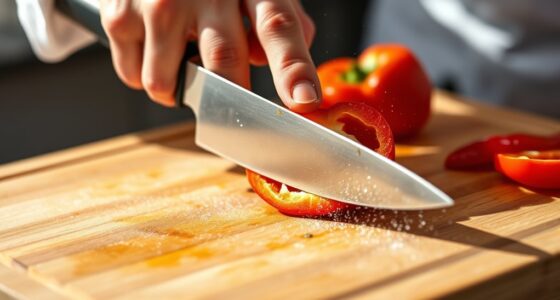Using colanders, sieves, and chinois can make your straining tasks easier and more efficient. A colander is perfect for draining pasta and rinsing produce, while sieves are ideal for sifting flour or straining sauces. A chinois excels at creating smooth purees and clearing stocks. Each tool has its specific function and material options like stainless steel or plastic. Once you understand their uses, you’ll find your kitchen work becomes quicker and neater—just keep exploring to learn more about mastering these essential tools.
Key Takeaways
- Use colanders for quick draining of pasta, fruits, and vegetables with their wide holes and open design.
- Choose fine-mesh sieves for delicate filtering, sifting flour, or removing small particles from sauces.
- Employ a Chinois for smooth purees and strained stocks, especially when a silky texture is desired.
- Ensure tools fit securely in sinks or bowls, and tap or shake gently to facilitate liquid flow.
- Mastering the proper use of each tool improves efficiency, results, and reduces mess in your kitchen.

Ever wondered how to make the process of straining easier and more efficient? Whether you’re preparing pasta, rinsing vegetables, or straining sauces, choosing the right tool can make all the difference. Colanders, sieves, and chinois each serve specific purposes, and understanding how to use them properly can save you time and frustration in the kitchen.
A colander is probably the most common straining tool in your kitchen. Its wide, bowl-like shape with numerous holes makes it perfect for draining pasta, washing fruits, or rinsing vegetables. You’ll find it made from stainless steel, plastic, or silicone, with handles for easy handling. When using a colander, make sure it fits securely in your sink or over a bowl to avoid spills. Place it under running water, then pour your contents in, allowing excess water to drain quickly through the holes. The open design ensures thorough rinsing and draining, but it’s less ideal for very fine particles or liquids that require finer separation.
Next, a sieve or fine-mesh strainer offers a more delicate approach. It’s ideal for sifting dry ingredients like flour, straining sauces or broths to remove solids, or rinsing small grains. The fine mesh catches tiny particles, giving you smooth, clean results. When you need to strain hot liquids or delicate ingredients, a sieve provides control and precision. To use it effectively, hold the handle steady over a bowl or pot, pour your mixture into the sieve, and gently shake or tap it to encourage the liquid to pass through. For stubborn residues, a gentle scraping with a spatula can help extract every bit of liquid or purée.
A chinois, sometimes called a conical strainer, takes straining to a professional level. Its tapered, fine mesh design allows for quick, thorough straining of liquids like sauces, stocks, or purees. The conical shape allows you to press or push ingredients through more easily, making it especially useful when you want silky, smooth results. You typically use a pestle or spatula to push ingredients down into the mesh. Because of its fine mesh and conical shape, the chinois can handle hot liquids and dense purées, making it a versatile tool for refined cooking. Using these tools correctly guarantees you get the best results: a perfectly strained sauce, clear broth, or smooth purée, all with less effort and mess. Mastering their use helps you become more efficient in the kitchen, letting you focus on the creative aspects of cooking rather than battling clogs or spills.
Frequently Asked Questions
Which Strainer Is Best for Indian Chaat or Street Food?
For Indian chaat or street food, a fine-mesh sieve or chinois works best. You want a strainer that can easily filter out small ingredients like spices, chickpea flour, or finely chopped vegetables. A chinois offers precision and smooth strain, helping you achieve the perfect texture. Use it to guarantee your ingredients are smooth and free of unwanted bits, enhancing the authentic taste and presentation of your street food.
Can I Use a Sieve for Baking Cake Flour?
A sieve works well for baking cake flour. As the saying goes, “A stitch in time saves nine.” You can use the sieve to aerate and evenly distribute the flour, preventing lumps and ensuring a light, fluffy cake. Just sift the flour through the sieve into your mixing bowl, and you’ll get a smooth, consistent texture that makes a noticeable difference in your baking results.
How Do I Prevent Food From Sticking to the Colander?
You prevent food from sticking to the colander by rinsing it thoroughly before use and applying a light coating of oil or non-stick spray if you’re draining sticky items. Additionally, avoid overcrowding the colander, which can cause sticking. Use a gentle swirl to loosen food if it begins to stick, and dry it well afterward. Proper cleaning and maintenance also help keep it non-stick for future use.
Are There Eco-Friendly Straining Options Available?
Think of eco-friendly straining options as a breath of fresh inspiration for your kitchen. You can choose silicone or bamboo strainers, which are reusable and biodegradable. These alternatives reduce plastic waste and are gentle on the environment. Plus, they work just as well as traditional metal or plastic options. By switching, you’re turning your kitchen into a greener space, making a positive impact with each meal you prepare.
How Do I Clean and Maintain a Chinois Effectively?
To clean your chinois effectively, rinse it immediately after use to prevent residue from drying. Use a soft brush or sponge with warm, soapy water to scrub the fine mesh gently. For stubborn spots, soak it briefly in warm soapy water before scrubbing. Make sure to dry it thoroughly to prevent rust. Regular maintenance keeps your chinois in top shape, ensuring it lasts and performs well for years.
Conclusion
Remember, when it comes to straining, simplicity is key. Whether you choose a colander, sieve, or chinois, you’re in control of the process. Just like the saying “A chain is only as strong as its weakest link,” your tools work best together to produce perfect results. So, trust these trusty kitchen helpers, and with a little practice, you’ll master straining with ease—making every recipe smoother and more satisfying.









